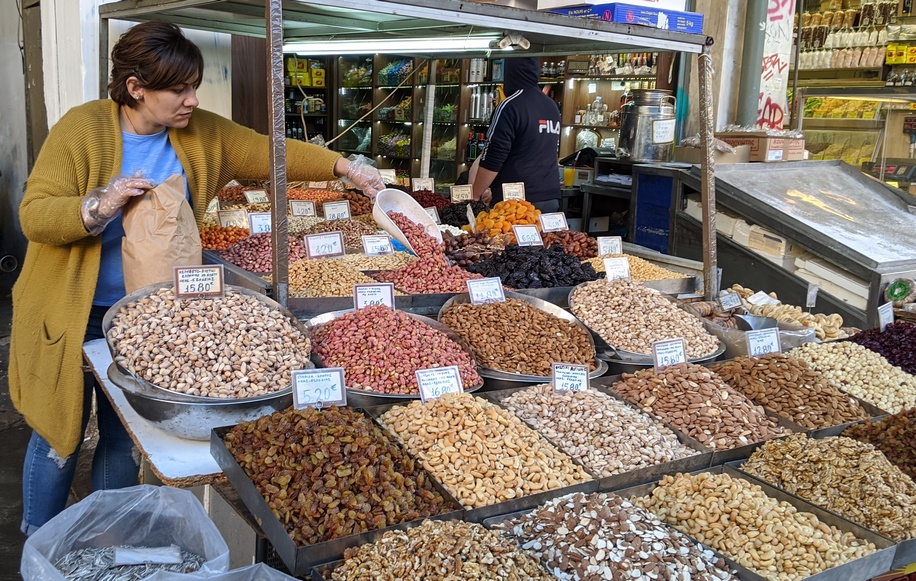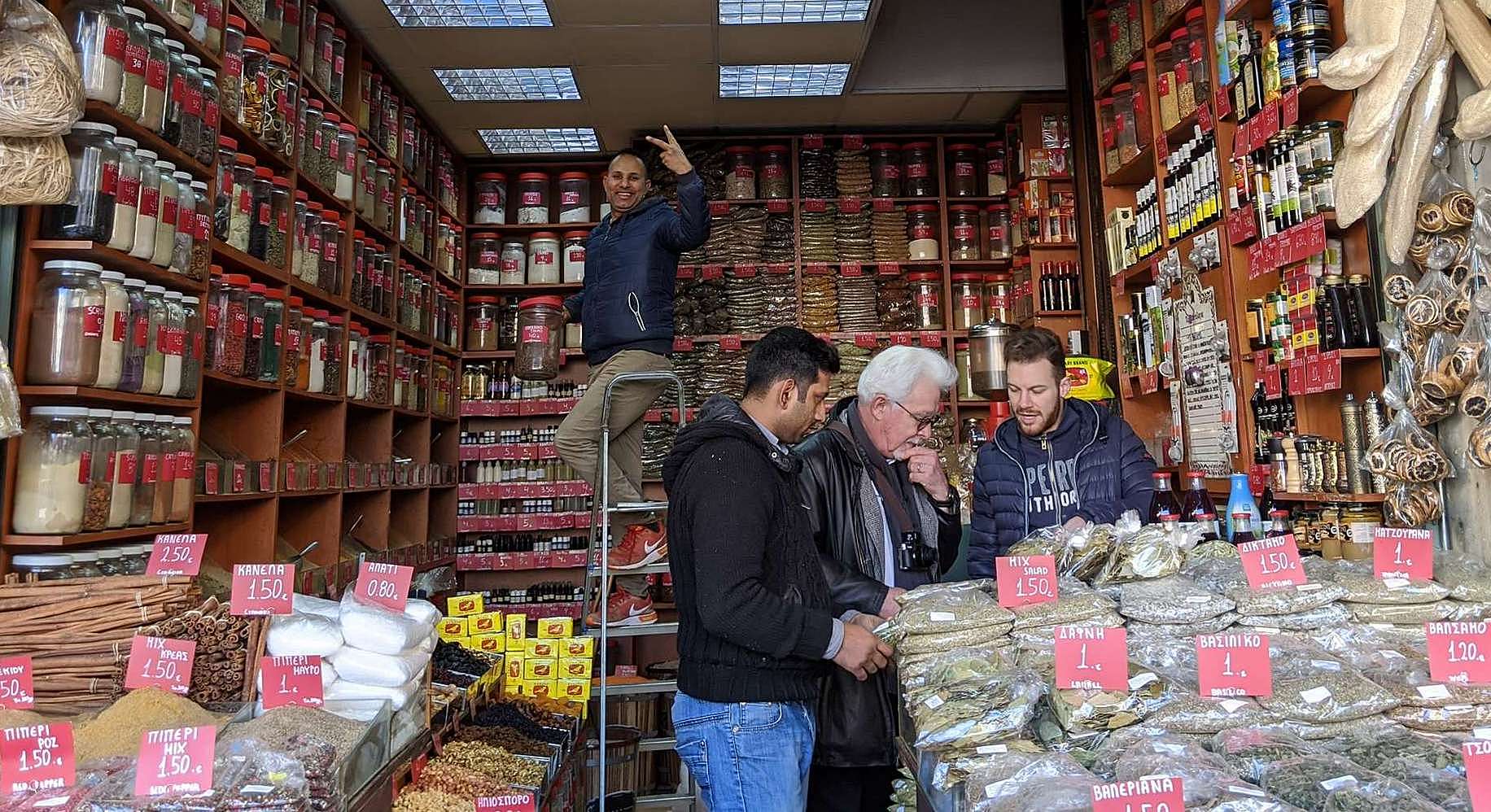As we all keep living in the eternal present, we are grateful for the recent past. Last winter we caught the Paris sales and moved on to Athens, a city we had wanted to visit for years. Even while we were there in our rented apartment, we kept seeing ominous news of an infection that was sweeping Wuhan in China. Not long after we got back to Boston in February, it had jumped to Lombardy. The rest is already history, with more in the making. But we wouldn’t give up that trip for anything.
Even Greek friends told us we’d get bored after three days in Athens, but for us, a week was still not enough. Beyond the amazing sites from antiquity and the stunning museums, there was Greek food. Followers of HungryTravelers are probably not surprised that after the Acropolis, the first place we went was the Central Market. That’s David in the top photo, surrounded by spice sellers.
Dried spices, fruits, and nuts suffuse Greek cuisine
 Food shopping at the Central Market in the winter was something of a surprise for us. For starters, the central part of the market is devoted to various kinds of fresh fish and to shockingly carnal displays of meat, mostly as whole carcasses butchered to order. The fish portion was easy to take, but the meat was a little too much for us Americans used to buying steaks, chops, and roasts from a refrigerator case—often on foam trays swathed in plastic wrap.
Food shopping at the Central Market in the winter was something of a surprise for us. For starters, the central part of the market is devoted to various kinds of fresh fish and to shockingly carnal displays of meat, mostly as whole carcasses butchered to order. The fish portion was easy to take, but the meat was a little too much for us Americans used to buying steaks, chops, and roasts from a refrigerator case—often on foam trays swathed in plastic wrap.
But we were struck by how essential dried and preserved foods are to Greek cuisine. Stall after stall proffered almonds, walnuts, dark raisins, prunes, figs, golden sultanas, and—of course—pistachios. The pistachios are extraordinary—even the run-of-the-mill pistachios. Those from the island of Aegina, about a 40-minute ferry ride from the Athenian port of Piraeus, are even better. The combination of dry climate, chalky soils, and proximity to the sea gives the Aegina fistikia a deeply concentrated flavor with a rounded sweetness. (We bought a big bag, but they were so addictive that we never got them home.) The E.U. recognizes the Aegina pistachio as a Protected Designation of Origin (PDO) product—a categorization comparable to the protected names of wine districts.
Our big score, though, was decorticated cardamom seed. When we asked about it at one voluminous spice stall, we were told to wait. One of the workers got a tall ladder, climbed to the topmost shelf in the back of the shop, and came down with a 10-liter jar full of the precious, sweetly aromatic spice. The jar was labeled €40 per kilo. A generous €5 bag (125 grams) was enough to last much of a lifetime! For good measure, we also picked up some excellent Greek saffron (Kronos brand) for a song.
A zillion styles of olives augment fresh produce
 Every part of Greece grows olives, and Greeks treat each regional variation almost like a separate product. So it wasn’t surprising that when we crossed the street (Athinas) to the open square where the fruit and vegetable vendors were set up, many stalls featured bucket after bucket of olives. Those didn’t make it home either….
Every part of Greece grows olives, and Greeks treat each regional variation almost like a separate product. So it wasn’t surprising that when we crossed the street (Athinas) to the open square where the fruit and vegetable vendors were set up, many stalls featured bucket after bucket of olives. Those didn’t make it home either….
Since we had rented an apartment, we could make use of fresh fruits and vegetables. When we asked, we learned that many were coming from elsewhere in the E.U.—notably Sicily and Spain. But the winter pomegranates, so red and luscious, hailed from the islands. They were truly kissed by the Greek sun.
Ultimately, we bought sparingly because part of the joy of being in Athens was going out to eat. The prices were modest, the food was brilliantly fresh, and by choosing carefully, we found ourselves at eateries primarily patronized by the locals.
In fact, we became sufficiently enamored of Greek cuisine that we have begun our own explorations at home using both products we purchased in Athens and those we are able to buy at shops in our local Greek and Armenian neighborhood that straddles the town lines of Watertown and Belmont in Massachusetts.
Keep posted!


